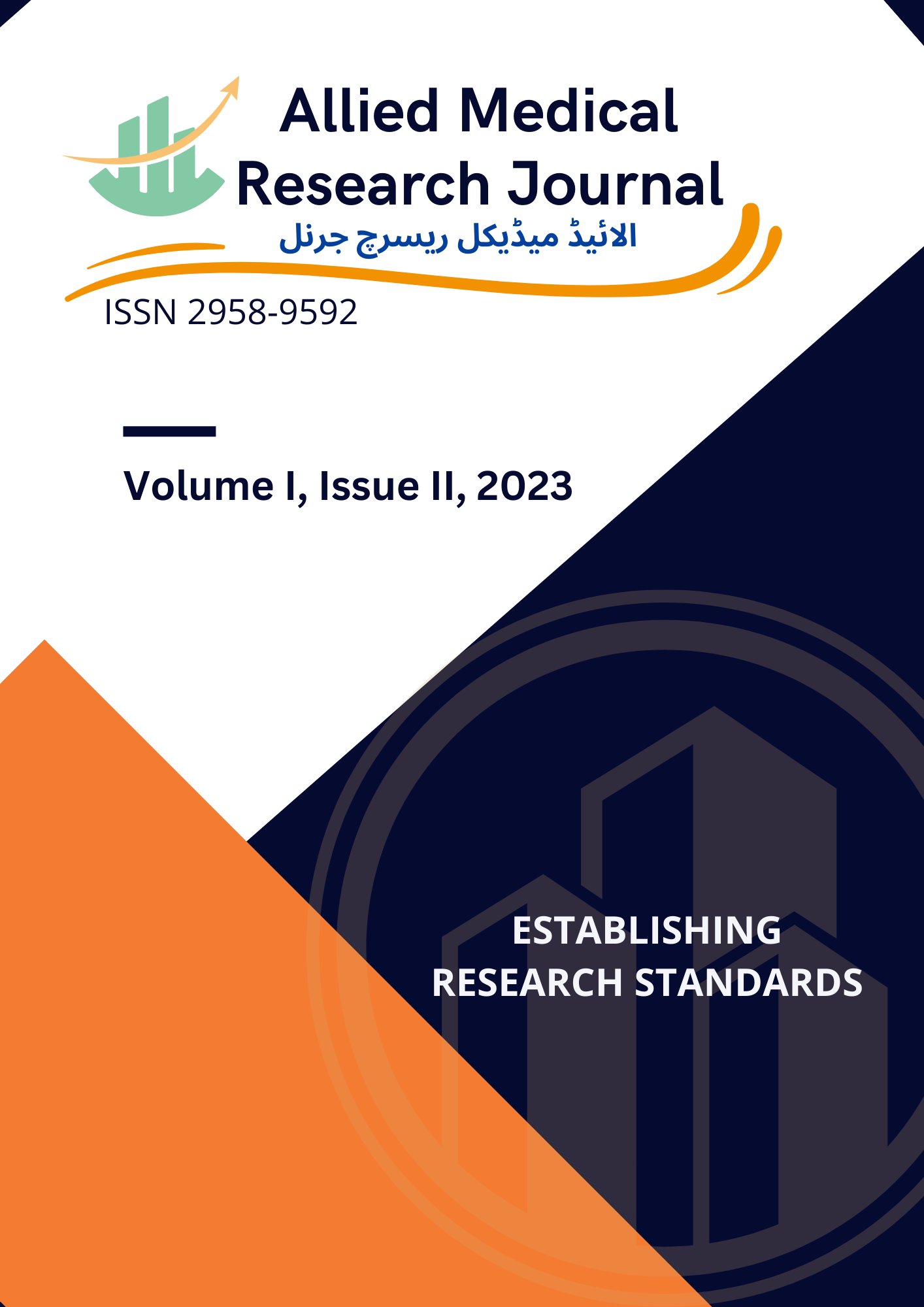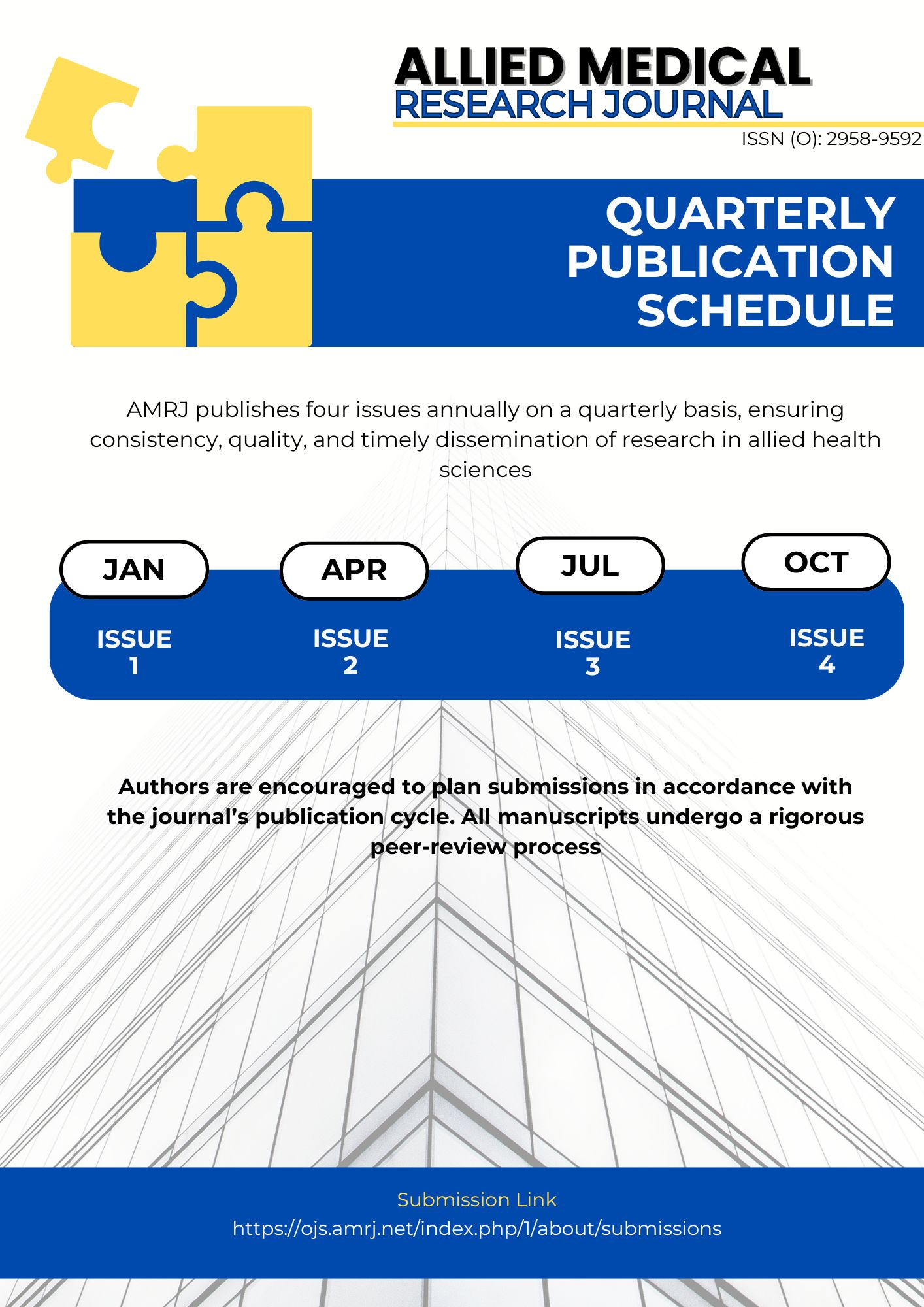Association between Clinical Frailty Scale and Risk of Hip Fractures among Geriatric Population
Keywords:
Geriatrics, Hip fracture, Frailty, OrthopedicsAbstract
Background
The study aims to identify the association between frailty and risk of hip fracture among the geriatric population admitted in the orthopaedic wards of tertiary care hospitals for the procedure of hip arthroplasty to determine if the cause of hip fracture is underlying frailty as estimated using a Clinical Frailty Scale.
Methods
A cross-sectional study was conducted in the orthopedic ward of a tertiary care hospital, involving a total of 345 geriatric individuals who were admitted due to a hip fracture. The study examined various factors related to hip fractures in individuals aged 65 years and above, encompassing both males and females.
Results
The association between clinical frailty scale and hip fracture were determined, and the findings revealed that 34.78% of the participants who had suffered from hip fracture had a clinical frailty score of 7 which is severely frail, whereas 29.85% had a clinical frailty score of 6 (moderately frail), 21.7% were at 5 (mildly frail), 3.76% were at a score of 4 (vulnerable), 2.89% were at a score of 3 (managing well), 2.31 at a score of 2 (well) and 1.73% who suffered from hip fracture were not frail at all and found at a score of 1 (very well).
Conclusion
A higher frailty score is associated with a higher risk of hip fracture among the older adult population.
References
Xu BY, Yan S, Low LL, Vasanwala FF, Low SG. Predictors of poor functional outcomes and mortality in patients with hip fracture: a systematic review. BMC Musculoskeletal Disorders. 2019;20(1):1-9.
Zhang C, Feng J, Wang S, Gao P, Xu L, Zhu J, Jia J, Liu L, Liu G, Wang J, Zhan S. Incidence of and trends in hip fracture among adults in urban China: a nationwide retrospective cohort study. PLoS Medicine. 2020;17(8):e1003180.
Downey C, Kelly M, Quinlan JF. Changing trends in the mortality rate at 1-year post hip fracture-a systematic review. World Journal of Orthopedics. 2019;10(3):166.
Kannus P, Parkkari J, Niemi S, Sievänen H. Continuously declining incidence of fall injuries in older adults: nationwide statistics from Finland between 1970 and 2016. European Geriatric Medicine. 2018;9:371-5.
Guzon-Illescas O, Perez Fernandez E, Crespí Villarias N, Quirós Donate FJ, Peña M, Alonso-Blas C, García-Vadillo A, Mazzucchelli R. Mortality after osteoporotic hip fracture: incidence, trends, and associated factors. Journal of Orthopedic Surgery and Research. 2019;14(1):1-9.
Bussell ME. Improving bone health: addressing the burden through an integrated approach. Aging Clinical and Experimental Research. 2021;33(10):2777-86.
Mortensen SJ, Mohamadi A, Wright CL, Chan JJ, Weaver MJ, von Keudell A, Nazarian A. Medications as a risk factor for fragility hip fractures: a systematic review and meta-analysis. Calcified Tissue International. 2020;107:1-9.
Zhang YW, Lu PP, Li YJ, Dai GC, Chen MH, Zhao YK, Cao MM, Rui YF. Prevalence, characteristics, and associated risk factors of the elderly with hip fractures: a cross-sectional analysis of NHANES 2005–2010. Clinical Interventions in Aging. 2021:177-85.
Carpenter CR, Southerland LT, Lucey BP, Prusaczyk B. Around the EQUATOR with clinician scientists transdisciplinary aging research (ClinSTAR) principles: Implementation science challenges and opportunities. Journal of the American Geriatrics Society. 2022;70(12):3620-30.
Abadir PM, Bandeen Roche K, Bergeman C, Bennett D, Davis D, Kind A, LeBrasseur N, Stern Y, Varadhan R, Whitson HE. An overview of the resilience world: Proceedings of the American Geriatrics Society and National Institute on Aging State of Resilience Science Conference. Journal of the American Geriatrics Society. 2023.
Church S, Rogers E, Rockwood K, Theou O. A scoping review of the Clinical Frailty Scale. BMC geriatrics. 2020;20(1):1-8.
Rockwood K, Theou O. Using the clinical frailty scale in allocating scarce health care resources. Canadian Geriatrics Journal. 2020;23(3):210.
Selcuk KT, Atan RM, Arslan S, Sahin N. Relationship between food insecurity and geriatric syndromes in older adults: A multicenter study in Turkey. Experimental Gerontology. 2023;172:112054.
Spellecy R, Busse K. The history of human subjects research and rationale for institutional review board oversight. Nutrition in Clinical Practice. 2021;36(3):560-7.
Chan S, Wong EK, Ward SE, Kuan D, Wong CL. The predictive value of the clinical frailty scale on discharge destination and complications in older hip fracture patients. Journal of Orthopaedic Trauma. 2019;33(10):497-502.
Zhao H, Wei P, Feng Y. Association between frailty and clinical outcomes and quality of life in older adults following hip fracture surgery: a retrospective cohort study. Anesthesia & Analgesia. 2022;134(5):1035-42.
Jorissen RN, Lang C, Visvanathan R, Crotty M, Inacio MC. The effect of frailty on outcomes of surgically treated hip fractures in older people. Bone. 2020;136:115327.
Hatcher VH, Galet C, Lilienthal M, Skeete DA, Romanowski KS. Association of clinical frailty scores with hospital readmission for falls after index admission for trauma-related injury. JAMA Network Open. 2019;2(10):e1912409-.
Wong BL, Chan YH, O’Neill GK, Murphy D, Merchant RA. Frailty, length of stay and cost in hip fracture patients. Osteoporosis International. 2023;34(1):59-68.

Downloads
Published
Issue
Section
License
Copyright (c) 2023 Abdul Majid, Muhammad Usman Khan, Abdul Ghafoor, Abid Khan

This work is licensed under a Creative Commons Attribution-NonCommercial 4.0 International License.








